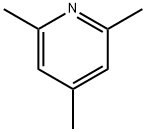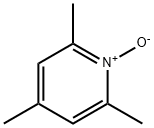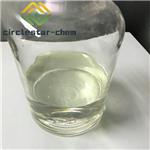Chemical Properties
colourless liquid
Uses
2,4,6-Collidine is an reagent used for various synthetic preparations such as the synthesis of methylated pyridines by three-componet catalytic condensation of acetylene, acetone and ammonia.
Uses
2,4,6-Collidine is used as a tissue fixative for electron microscopy. It is useful in dehydrohalogenation reactions and acts as a solvent for the cleavage of hindered esters by anhydrous lithium iodide.
Definition
Methyl, ethyl, propyl, and trimethyl homologs of
pyridine.
Synthesis Reference(s)
Journal of the American Chemical Society, 72, p. 4184, 1950
DOI: 10.1021/ja01165a097
General Description
2,4,6-Trimethylpyridine is a pyridine derivative. It has a pK of 7.4. The product can react with trifluoroiodomethane in cyclopentane solution to afford 1:1 complex. This complex was investigated by NMR (Nuclear Magnetic Resonance) spectroscopy. Collidine-buffered osmium tetroxide solutions have been prepared by adding osmium tetroxide solution to it. These solutions have been used as fixative for electron microscopic studies.
2,4,6-Trimethylpyridine can undergo oxidation with potassium permanganate to form 2,4,6-pyridinetricarboxylic acid.
Flammability and Explosibility
Flammable
Purification Methods
Commercial samples may be grossly impure. Likely contaminants include 3,5-dimethylpyridine, 2,3,6-trimethylpyridine and water. Brown, Johnson and Podall [J Am Chem Soc 76 5556 1954] fractionally distilled 2,4,6-trimethylpyridine under reduced pressure through a 40cm Vigreux column (p 11) and added to 430mL of the distillate slowly, with cooling to 0o, 45g of BF3-diethyl etherate. The mixture was again distilled, and an equal volume of dry *benzene was added to the distillate. Dry HCl was passed into the solution, which was kept cold in an ice-bath, and the hydrochloride was filtered off. It was recrystallised from absolute EtOH (1.5mL/g) to m 286-287o[m 256o(sealed tube), also m 293-294o subliming slowly]. The free base was regenerated by treatment with aqueous NaOH, then extracted with *benzene, dried (MgSO4) and distilled under reduced pressure. Sisler et al. [J Am Chem Soc 75 446 1953] precipitated trimethylpyridine as its phosphate from a solution of the base in MeOH by adding 85% H3PO4, shaking and cooling. The free base was regenerated as above. Garrett and Smythe [J Chem Soc 763 1903] purified the trimethylpyridine via the HgCl2 complex. It is more soluble in cold than hot H2O [the solubility is 20.8% at 6o, 3.5% at 20o, 1.8% at 100o]. Alternatively, purify it by dissolving it in CHCl3, adding solid K2CO3 and Drierite, filtering and fractionally distilling through an 8in helix-packed column. The sulfate has m 205o, and the picrate (from hot H2O) has m 155-156o. [Frank & Meikle J Am Chem Soc 72 4184 1950, Beilstein 20 H 250, 20 I 87, 20 II 164, 20 III/IV 2810, 20/6 V 93.]






